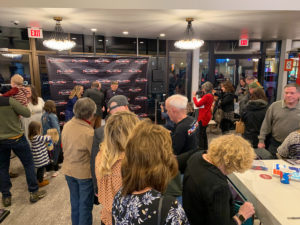 In this edition of “Ask Christian?” we are going to tackle the latest and the most significant challenge faced so far by our production team, the archival material. Supporters following the progress of this project will remember that many of our team and supporters gathered in February to celebrate the story and picture lock of The Girl Who Wore Freedom. On February 6, we shared the latest version of the film with family and friends at a focus group event in Arlington Heights, IL. It was a memorable evening, and we were truly blessed by the feedback and encouragement we received.
In this edition of “Ask Christian?” we are going to tackle the latest and the most significant challenge faced so far by our production team, the archival material. Supporters following the progress of this project will remember that many of our team and supporters gathered in February to celebrate the story and picture lock of The Girl Who Wore Freedom. On February 6, we shared the latest version of the film with family and friends at a focus group event in Arlington Heights, IL. It was a memorable evening, and we were truly blessed by the feedback and encouragement we received.
The most common question that night was, “What’s next for “The Girl Who Wore Freedom?” There is a lot still in store for the film this year, including festivals, discussions with distributors about distribution deals, and more. However, these next steps are contingent on one thing: finishing the film. We understand this may be confusing for our supporters because The Girl Who Wore Freedom looks, sounds, and feels like a finished movie. Here are a few of the things that still need completion: fine editing, additional sound design, score revisions, color mixing and grading, rights and clearances, legal review, and completion of our distribution deliverables.
The Girl Who Wore Freedom is, at its core, a historical work, which utilizes many archival elements to tell the story of the French people on D-Day. 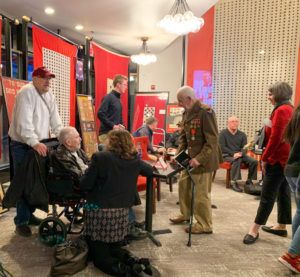 These elements, whether photos, songs, or video recordings, play a critical part in bringing our story to life. As a result, securing the rights and clearances for this project has become the most time consuming, expensive, and challenging task we have taken on yet. To better understand the challenges ahead for the team, we asked our Director and Executive Producer, Christian Taylor, the following questions.
These elements, whether photos, songs, or video recordings, play a critical part in bringing our story to life. As a result, securing the rights and clearances for this project has become the most time consuming, expensive, and challenging task we have taken on yet. To better understand the challenges ahead for the team, we asked our Director and Executive Producer, Christian Taylor, the following questions.
What does “Rights and Clearances” mean?
“Rights and clearances” is the process of licensing property for use publicly. In a film, this includes obtaining the material and then documenting that your project has the right or has been cleared to use an image, news footage, or music in that film. Kenn Rabin, in a February 2015 article entitled “A Conversation with Selma Archive Producer Kenn Rabin” shared the challenges he faced while working on the movie Selma.
“You have to clear all rights, all media, in perpetuity, worldwide. In other words, everything. We reviewed a certain amount of public-domain material. … But we didn’t use any of the public-domain material, as I recall. We had to clear everything commercially.
Prices to clear various markets vary widely among the archives. An archive that’s associated with a university, historical society, or museum might be less expensive; those archives may also set pricing based on for-profit or not-for-profit use. With a commercial archive, you’re paying based on the market that you’re clearing. The average cost to clear rights for Selma was somewhere between $100 and $150 per second, and in most cases the minimum is 30 seconds. … So we ended up spending about $33,000 on rights for less than two minutes of footage in the final film. Audiovisual historical storytelling can be very expensive.”
The Girl Who Wore Freedom film has just under 300 archival items that need the rights documented or cleared. At the time of this article, only 20% have been cleared. Another 40% of them are “in-process,” which means we have a line of sight on how to secure the rights. The other 40% of our items need to be found and cleared or purchased. Luckily many of the items used in the film are considered part of the public domain. Public Domain means the general public owns these works, not an organization, individual, or artist. However, even with these items, the production team still must locate the original photo or footage in the National Archived. We then need to document the source/ownership of the image or footage and obtain the master file, if possible.
What is the master file, and why do we need it to finish the film?
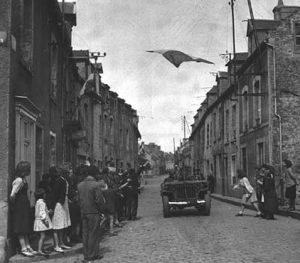 During the production and post-production process of a film, directors and editors work with lower resolution images, sometimes called “proxies” or “screeners.” These images are used for evaluation and rough editing. Due to their smaller size, these images often lack the detail and clarity of the original. Once the film reaches picture-lock, the production team replaces the initial “proxies” with higher quality versions, called “masters.” For the footage shot during the principal filming, this is easy. When your film also includes archival items, the process becomes more challenging. To obtain photo and video originals files can cost from under fifty dollars to several hundreds of dollars depending on the type, the size, and the source.
During the production and post-production process of a film, directors and editors work with lower resolution images, sometimes called “proxies” or “screeners.” These images are used for evaluation and rough editing. Due to their smaller size, these images often lack the detail and clarity of the original. Once the film reaches picture-lock, the production team replaces the initial “proxies” with higher quality versions, called “masters.” For the footage shot during the principal filming, this is easy. When your film also includes archival items, the process becomes more challenging. To obtain photo and video originals files can cost from under fifty dollars to several hundreds of dollars depending on the type, the size, and the source.
Many supporters that have seen earlier versions of the film, this step may not seem necessary. We hear all the time, “the film is beautiful, don’t change a thing.” However, to distribute The Girl Who Wore Freedom, this is a critical step. Have you ever looked at a friend’s vacation photos and there is one shot that isn’t quite right, it may be too dark or blurry or way too small? The conversation always turns to what happened with that one bad shot instead of the story surrounding their fantastic experience. We believe that we have a fantastic story to tell too. The production team has worked tirelessly to ensure that all the footage, every picture, and map support the story of sacrifice, friendship, and restoration that we are trying to tell. If a picture is worth a thousand words, then we want the best for The Girl Who Wore Freedom.
What is an Archival Producer, and does The Girl Who Wore Freedom have one?
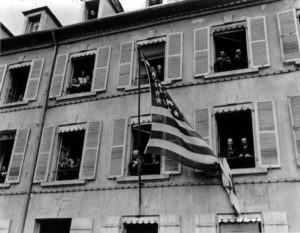 The most straightforward answer is that an Archival Producer works with the director, producers, and lead editor to determine the archival needs of a film, which helps shape the story narrative. This producer works with the film’s Producer and Director in both the pre-production and post-production phase. They manage and log all the archival materials coming from archivists or researchers, help locate relevant items, and record everything into the production system. In the post-production phase, the Archival Producer works with the Editor to best use archival elements for narrative and budget. They coordinate with legal counsel regarding any licensing questions, license, and obtain masters for all archival items once they have been “locked” into the film. Finally, they work with the Producers to organize and complete all the archival deliverables, including a document known as the “Rights Bible.”
The most straightforward answer is that an Archival Producer works with the director, producers, and lead editor to determine the archival needs of a film, which helps shape the story narrative. This producer works with the film’s Producer and Director in both the pre-production and post-production phase. They manage and log all the archival materials coming from archivists or researchers, help locate relevant items, and record everything into the production system. In the post-production phase, the Archival Producer works with the Editor to best use archival elements for narrative and budget. They coordinate with legal counsel regarding any licensing questions, license, and obtain masters for all archival items once they have been “locked” into the film. Finally, they work with the Producers to organize and complete all the archival deliverables, including a document known as the “Rights Bible.”
Sadly, we do not have an Archival Producer on the team at present. Christian says this is something else for the list of things she learned as a first-time filmmaker. Thankfully, we do have a crew of dedicated volunteers researching the National Archives online collections and documenting that the items used in our film are in the public domain. When possible, they are also downloading available items and organizing them. These volunteers are also negotiating and licensing rights for all of the photos, music, and video clips used on The Girl Who Wore Freedom that are not in the public domain. Their work has been an incredible blessing, but in the end, TGWWF will have to employ a professional archivist to get this project across the finish line
What then is an Archivist?
That is an excellent question, thanks for sticking with us this far. An archivist is a professional with a background in history, library, or information management that is responsible for maintaining and organizing an archival collection. Archivists spend a lot of their time preserving the items currently in a collection or searching for additional items that belong in the collection. In some cases, they assess the value of items from either public or private collections. The main job of an archivist is to make the items in a collection available to historians, educators, the general public, and filmmakers. Often you will hire an archivist to act as a guide pulling maps, photos, or videos relating to a search.
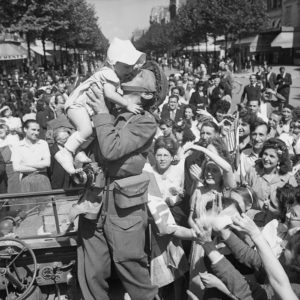 Here in the United States, we have the National Archives and Records Administration (NARA), which is an independent agency charged with the preservation and documentation of government and historical records. Currently, the National Archives employs about 3,000 employees, either full or part-time. However, the number of items in the archive outnumbers employees about 1 million to 1. Even if you narrow the search to just World War II, the number of items available to search is overwhelming, and many are not available online. One solution is to hire an archivist familiar with the NARA at the daily rate of $450 per day.
Here in the United States, we have the National Archives and Records Administration (NARA), which is an independent agency charged with the preservation and documentation of government and historical records. Currently, the National Archives employs about 3,000 employees, either full or part-time. However, the number of items in the archive outnumbers employees about 1 million to 1. Even if you narrow the search to just World War II, the number of items available to search is overwhelming, and many are not available online. One solution is to hire an archivist familiar with the NARA at the daily rate of $450 per day.
We hope that these questions and answers have given you a sense of the work that remains for the team working on The Girl Who Wore Freedom. One team member recently commented that we had entered the most unglamorous and unknown phase of making a documentary. We are thankful, so many of you have chosen to follow and support this project and every phase of production so far. Our success rests entirely in the fantastic grassroots support that we have received in the States, in France, and abroad in the last three years. All that now stands in the way of The Girl Who Wore Freedom reaching a wider audience is this final critical phase. Please consider helping us spread the word through social media or supporting us financially at Normandystories.com.


Who knew?! Thanks for answering these important questions, Christian, and thanks Melissa, for helping make it understandable to the average person!